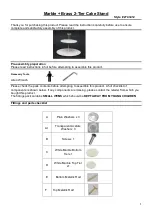
20 SERIAL COMMUNICATION INSTRUCTIONS
20.2 Executing the Protocols Registered for the Predefined Protocol Support Function
1679
20
Processing details
• The protocol setting data written to the flash ROM is executed using the module specified by (U). All the protocols to be
executed follow the contents of the control data that has been stored in the device specified by (s) and later. The channel
specified by (n1) is used.
• One attempt of the instruction consecutively executes the specified number of protocols (by (n2); maximum 8).
• The completion status of the G(P).CPRTCL instruction can be checked with the completion device (d) and the completion
status indication device (d)+1.
• The following figure shows how the G(P).CPRTCL instruction operates when completing its execution.
The program execution status can be checked with the buffer memory (address: 4041H/4051H).
■
Canceling protocol execution
A protocol can be canceled during its execution.
This function forcibly terminates the protocol being executed when a communication error occurs with the external device.
The function can be executed in the predefined protocol mode only.
• How to cancel the protocol execution
A cancellation can be requested using a sequence program.
Use the following buffer memory areas.
• Operation after the cancellation is requested
[Operation of the dedicated instruction (G(P).CPRTCL)]
The instruction completes with an error, and the error code is stored in (s)+0 (Execution result). If multiple protocols are being
executed sequentially, the cancellation-target protocol ('n'th protocol) is forcibly terminated, and the subsequent protocols are
not executed.
[Operation of the C24]
If the function is executed (a cancellation is requested) while no protocol is being executed, the C24 performs no processing.
If the function is executed in the mode other that the predefined protocol mode, the value in the corresponding buffer memory
area is ignored.
• Completion device (d)
This device turns on during END processing of the scan where the G(P).CPRTCL instruction completes, and turns off during the next END processing.
• Completion status indication device (d)+1
This device turns on or off depending on the completion status of the G(P).CPRTCL instruction.
When completed successfully: The device remains off.
When completed with an error: The device turns on during END processing of the scan where the G(P).CPRTCL instruction completes, and turns off during the
next END processing.
Address (decimal (hexadecimal))
Name
Set value
CH1
CH2
16448 (4040H)
16464 (4050H)
Protocol cancellation specification
0: No cancellation specified
1: Cancellation requested (by user)
2: Canceled (by the C24)
END
0
END
0
END
0
END
0
OFF
OFF
OFF
OFF
ON
ON
Sequence scan
G(P).CPRTCL instruction
Completion device (d)
1 scan
Completion of the instruction
Completed successfully
Completed with an error
Execution of the instruction
Completion status
indication device (d)+1
Summary of Contents for MELSEC iQ-R Series
Page 1: ...MELSEC iQ R Programming Manual Instructions Standard Functions Function Blocks ...
Page 2: ......
Page 24: ...22 INDEX 2092 INSTRUCTION INDEX 2093 REVISIONS 2104 WARRANTY 2105 TRADEMARKS 2106 ...
Page 34: ...32 MEMO ...
Page 35: ...33 PART 1 PART 1 OVERVIEW This part consists of the following chapter 1 OVERVIEW ...
Page 68: ...66 1 OVERVIEW 1 5 Precautions on Programming MEMO ...
Page 1448: ...1446 14 REDUNDANT SYSTEM INSTRUCTIONS 14 2 Disabling Enabling System Switching MEMO ...
Page 1972: ...1970 33 TIME DATA TYPE FUNCTIONS 33 4 Division MEMO ...
Page 2067: ...APPX Appendix 5 PID Control Program Examples 2065 A 252 Set PID control data for loop 2 ...
Page 2109: ......
















































